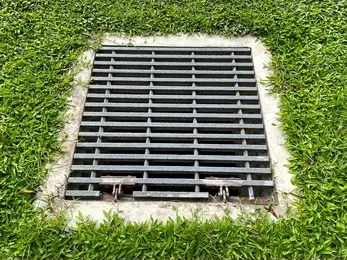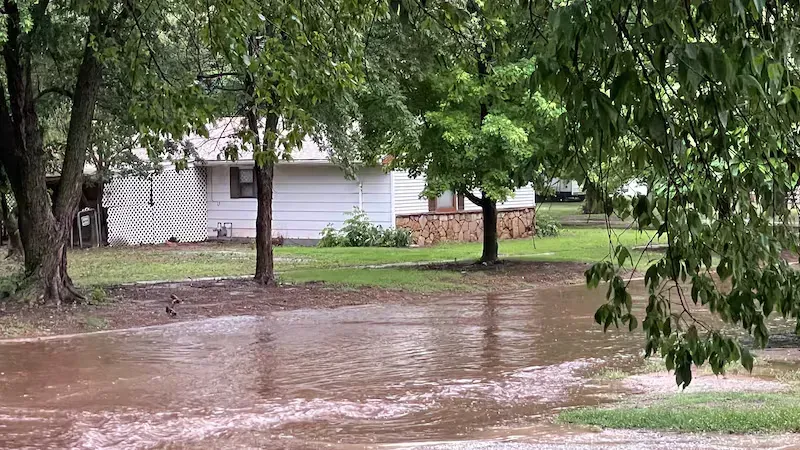Our Catch Basin Installation Process
We follow the same proven process for every catch basin installation in Wichita. Our goal is to build a system that works right the first time and keeps working for years. Here's exactly what happens when you work with us.
Site Evaluation and Drainage Assessment
Before we dig anything, we come to your property to figure out the best plan. We walk around and look at how water flows across your yard after rain. We check where it pools, where it goes, and where it should go instead.
We analyze your property's slope, even the tiny grades that don't look like much. On flat Wichita lots, every inch of slope matters when you're trying to move water. We also check your soil, clay soil drains differently than sandy soil, and that changes how we design your system.
During this visit, we locate any underground utilities like gas, electric, or water lines. Nobody wants a shovel through a gas line. We also look at where your gutter downspouts drain and whether we should connect them to your new catch basin system.
We identify the best discharge locations for your water. Maybe it's the street, a storm drain connection, or a spot on your property where water can safely drain away. Every property is different.
We check Sedgwick County permit requirements too. Some projects need permits, some don't. If yours does, we handle all that paperwork for you.
By the end of our evaluation, we know exactly where your catch basins need to go, how deep they need to be, and where the water will end up. We design a custom solution for your specific property, not some cookie-cutter setup that might not work.
Excavation and Basin Placement
Once you approve the plan, we start digging. We mark out the exact locations for each catch basin and start excavation.
Depth matters in Wichita. We dig below the freeze line, about 30 inches down, so freeze-thaw cycles in winter don't damage your system. Concrete catch basins and plastic catch basins both need to sit below that frost line.
If your property is really flat, we create slope where there isn't much natural grade. Water won't flow uphill, so we make sure every basin and pipe has enough slope to keep water moving.
We install the basin units with proper sediment traps at the bottom. These traps catch dirt and debris before they flow into your underground pipes. That's what keeps your system from clogging up.
Next, we connect the basins to underground drainage pipes. If it makes sense, we integrate your existing gutter downspout systems right into the catch basins. This way, roof water and yard water all drain through one complete system.
Everything gets set in a stable base, either a concrete bed or gravel, depending on the application. We level everything and check it multiple times before moving forward. If a basin settles later, water won't drain right.
Pipe Installation and Discharge Setup
After the catch basins are in place, we install the underground pipes that connect everything. These pipes carry water from the basins to wherever it discharges.
Your discharge options depend on your property. We can connect to the street if that's allowed, tie into an existing storm drain, or run to a drainage easement. Sometimes we use pop-up emitters at the end of the line, these stay closed until water pushes through, then pop up to let it out.
The slope of these pipes is critical, especially on flat Wichita lots. Even underground, water needs a slope to flow. We make sure every foot of pipe angles down toward the discharge point.
If you want your gutters tied in, we connect those downspouts to the catch basin drainage systems during this step. No more water dumping next to your foundation. Instead, it flows underground to a safe spot far from your house.
Grate Installation and Testing
With all the pipes and basins in place, we install the catch basin grates on top. We pick grates based on what's driving or walking over them. Residential driveways get medium-duty grates. Parking lots need heavy-duty options. Walkways might need smaller openings that meet ADA requirements so canes and wheelchair wheels don't get caught.
The grates sit perfectly flush with your yard or driveway surface. You shouldn't feel a bump when you drive over them. They should look like they've always been there.
Before we call the job done, we test everything. We run water through the system to make sure it flows correctly and drains completely. We check that there's no standing water in the basins or low spots in the pipes. We verify that water is going where it should at the discharge point.
If we find any issues during testing, we fix them right then. You only pay for a residential catch basin system that works perfectly.
Finally, we clean up completely. We haul away the dirt, smooth out the area, and leave your property looking good.
Most residential catch basin installations take one to three days, depending on how many basins you need and how much pipe we're running. We work efficiently and keep you updated the whole time.


